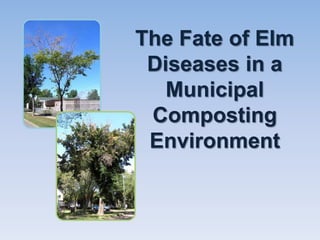
Fate of Elm Diseases in Municipal Composting
- 1. The Fate of Elm Diseases in a Municipal Composting Environment
- 2. PROJECT OVERVIEW Goal: To determine whether or not elm diseases are destroyed during composting Implication: Determine whether or not diseased wood must be kept out of compost feedstocks
- 3. PRESENTATION OVERVIEW Project Background & Objectives Procedures – Inoculation Experiments and Composting Trials Composting Trials - Results Summary and Recommendations
- 4. BACKGROUND – PROJECT IMPETUS Edmonton’s Gore composter processes biosolids and wood chips Parks Branch provides clean green wood Diseased wood from Forestry is diverted to landfill Reduces risk of disease spread Parks Branch is a major consumer of Gore compost
- 5. BACKGROUND – PROJECT IMPETUS Possibility of diverting a portion of Forestry’s diseased wood from the landfill. There are other contributors of wood to the Gore process Not necessarily screened Need to determine the fate of some common local plant diseases during composting
- 6. BACKGROUND – SOME COMMON DISEASES Dothiorella ulmi D. ulmi-infected elm makes up the majority of landfilled wood Verticillium dahliae and V. albo-atrum Have been isolated from elm in Edmonton area Have wide host ranges
- 7. LITERATURE REVIEW Plant pathogens can be inactivated by exposure to heat Heat tolerance varies by organism and form No time-temperature guidelines for plant pathogens in North America Human pathogens: 55oC for 3 days
- 8. LITERATURE REVIEW Verticillium dahliae Eliminated in small-scale composter when material turned, Tmax ≈ 70oC, and T > 50oC for 10-14 days V. albo-atrum & Dothiorella ulmi Nothing in the literature D. ulmi laboratory incubation tests suggest that typical composting temperatures should be adequate Fungi and fungi-like species Some species survived T > 55oC
- 9. SPECIFIC OBJECTIVES Determine to what degree D. ulmi, V. dahliae, and V. albo-atrum are inactivated by time-temperature conditions in Gore composter. How likely is it that these organisms will be eradicated in the Gore composter? Does diseased wood need to be diverted from the composter?
- 10. OVERALL EXPERIMENTAL PLAN Wood chip inoculation experiments Place bagged infected wood chips in the Gore system during the high-temperature phase Periodically recover bags and evaluate pathogen survival in composted elm wood
- 11. PROCEDURES - WOOD CHIP INOCULATION Wood chip inoculation procedure optimized Inoculum prepared from fungal cultures Wood chips sterilized by autoclaving, then sprayed with inoculum and agar plugs placed Incubated for 26 days at 22°C Verticillium Dothiorella ulmi albo-atrum Control Verticillium dahliae
- 12. PROCEDURES – SAMPLE PREPARATION Infested wood chips sealed in sterilized Ziploc bags (with air space). Organisms affected by temperature only. Ziplocs placed into nylon mesh bags “Sample bundles” created One bag for each organism, plus a temperature probe.
- 13. PROCEDURES – SAMPLE PLACEMENT
- 14. PROCEDURES – SAMPLE PLACEMENT (October 13 2009)
- 15. PROCEDURES – SAMPLE COLLECTION AND TESTING Sample bundles and compost samples collected periodically Every day or two for first week, and weekly or biweekly thereafter. Wood chips tested for pathogen survival Temperature data examined
- 16. RESULTS – TEMPERATURE Pile construction/ sample insertion Pile completion 80 Ambient X1 AVG. 70 X2 X3 60 X4 X5 50 X6 Temperature (oC) X7 40 On-Site (~0.8m deep) On-Site (~0.2m deep) 30 20 10 0 -10 0 7 14 21 28 35 42 Time (days)
- 17. RESULTS – PATHOGEN SURVIVAL VS. TEMPERATURE Sample Location X1 X2 X3 X4 X5 X6 X7 ≥ 70 °C 0 0 0 0 0 0 8.7 Total amount ≥ 65 °C 0 0 0 0 0 0 11.2 of time ≥ 60 °C 0 0 0 0 0.8 0 13.7 (days) that ≥ 55 °C 0 0 0 0 2.6 3.2 21.5 various ≥ 50 °C 0 0 0 0 12.3 16.0 35.6 temperatures ≥ 45 °C 0 0 0 7.1 20.3 26.5 39.7 were ≥ 40 °C 0 0 5.5 11.1 26.1 30.0 39.9 exceeded ≥ 35 °C 0 0 11.7 17.6 34.4 38.5 40.0 ≥ 30 °C 0 0 21.3 30.1 38.6 38.9 40.1 Pathogen D. ulmi + + - - - - - survival at V. albo- end of atrum + + - - - - - composting V. dahliae + + - - - - -
- 18. RESULTS – PATHOGEN SURVIVAL VS. TEMPERATURE Bags at locations where pathogen destruction was seen were compressed. Testing was done at room temperature in compressed (anoxic) bags Pathogens survived anoxic conditions
- 19. CONCLUSIONS Appears that D. ulmi, V. albo-atrum, and V. dahliae will be inactivated if temperatures exceed 40°C for more than 5.5 days. Likely to occur in interior of pile; perhaps not in outer layer. Important to ensure that all materials from exterior zones in Stage 1 get mixed into higher temperature zones in subsequent stages. May not need to divert diseased wood to landfill.
- 20. RECOMMENDATIONS Repeat trial 2x more, with modifications to improve procedures, e.g. Better sorting of wood chips Use of rigid sample containers Study temperature profiles in Gore Stages 2 and 3 (curing) in detail Potential small-scale reactor study Pinpoint time-temperature requirements Determine suitable indicator organisms
- 21. ACKNOWLEDGEMENTS
- 22. CONTACT INFO Kristine Wichuk kwichuk@ualberta.ca Daryl McCartney daryl.mccartney@ualberta.ca
- 23. The Fate of Elm Diseases in a Municipal Composting Environment
- 26. RESULTS – COMPOST Pathogen survival not affected directly by MC, pH, or C:N MC : ~53% to ~62% at start ~32% to 55% at end pH : ~7.6 to ~7.8 at start ~7.3 to ~8.4 at end C:N: varied throughout pile at start and end
- 27. RESULTS – PATHOGEN SURVIVAL X2, Day 42 X7, Day 42 D. ulmi V. dahliae V. albo-atrum
